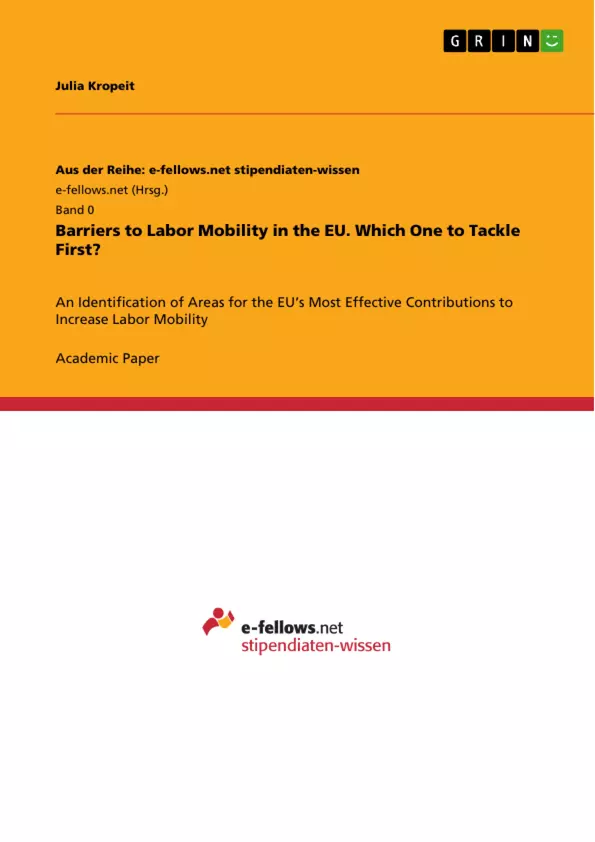With the right of free movement across borders being granted to all EU citizens, why do European workers remain locally bound even in times of crises? This question has given rise to a large number of studies and discussions on existing barriers to labor mobility which have persisted despite the legal freedoms. The goal if this essay is threefold: it will identify the most critical barriers, show via which mechanisms these barriers can be lowered, and assess for which barriers the EU, considering its capacities and those of Member States and conforming to the subsidiarity principle, can have the greatest direct impact on lowering them. While the essay will not directly evaluate the effectiveness of previous EU policies targeted towards increasing labor mobility, it will show in which areas increased efforts by the EU can transform into tangible results in the most efficient way.
The essay proceeds in the following way: In the first section, it recaps the economic rationale underlying the importance of labor mobility in a monetary union. In the second section, it shows which patterns of labor mobility can currently be observed in the EU. Section three introduces the four key barriers that constrain labor mobility in the EU, and section four outlines through which mechanisms these barriers can be addressed and provides the assessment of the EU’s impact on lowering them.
Inhaltsverzeichnis (Table of Contents)
- Introduction
- The Economic Role of Labor Mobility in a Monetary Union
- The Status Quo of Labor Mobility in the EU
- Four Key Barriers to Labor Mobility in the EU
- Language requirements
- Recognition of qualifications
- Intransparency of foreign job markets
- High mobility costs
- Housing market frictions
- Pension entitlements
- Unemployment benefits
Zielsetzung und Themenschwerpunkte (Objectives and Key Themes)
This essay aims to identify the most critical barriers to labor mobility in the EU, demonstrate how these barriers can be lowered, and assess the EU's potential impact on reducing them. It focuses on the most effective ways for the EU to contribute to increased labor mobility, considering its own capacities and those of Member States while adhering to the principle of subsidiarity.
- The economic rationale for labor mobility in a monetary union
- The current status of labor mobility within the EU
- Key barriers hindering labor mobility, including language requirements, qualification recognition, intransparency of foreign job markets, and high mobility costs
- Mechanisms for addressing these barriers
- The EU's potential to influence the reduction of these barriers
Zusammenfassung der Kapitel (Chapter Summaries)
- Introduction: This section sets the context for the essay by highlighting the contrasting unemployment rates between Northern and Southern European countries. It introduces the central question of why European workers remain locally bound despite the freedom of movement within the EU, and outlines the essay's objectives.
- The Economic Role of Labor Mobility in a Monetary Union: This chapter explores the benefits and costs of joining a monetary union. It emphasizes the importance of labor mobility as an adjustment mechanism to counter asymmetric demand shocks, particularly in the absence of monetary policy flexibility. The chapter discusses two mechanisms for adjustment: wage flexibility and labor mobility, highlighting the advantages of the latter in terms of speed and efficiency.
- The Status Quo of Labor Mobility in the EU: This section analyzes the historical trends and current dynamics of labor mobility within the EU. It acknowledges the limitations of labor mobility in the past and provides evidence of its slow pace. The chapter also highlights a potential shift in recent years, with growing willingness among Europeans to relocate for work, particularly among younger generations.
- Four Key Barriers to Labor Mobility in the EU: This chapter identifies and explains four major barriers to labor mobility within the EU: language requirements, recognition of qualifications, intransparency of foreign job markets, and high mobility costs, which are further broken down into housing market frictions, pension entitlements, and unemployment benefits.
Schlüsselwörter (Keywords)
The main keywords and focus topics of this text include labor mobility, economic governance, EU policy, monetary union, asymmetric demand shocks, wage flexibility, qualification recognition, language barriers, mobility costs, intransparency, and the principle of subsidiarity.
- Quote paper
- Julia Kropeit (Author), 2012, Barriers to Labor Mobility in the EU. Which One to Tackle First?, Munich, GRIN Verlag, https://www.hausarbeiten.de/document/1275904


